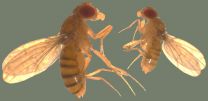INFORMATION:
http://www.plosgenetics.org/article/info:doi/10.1371/journal.pgen.1004764 END
New mechanism for growth control discovered
2014-11-14
(Press-News.org) Animal growth is closely regulated by environmental factors such as nutrition. If the nutrition of a growing animal is limited, growth slows down and the eventual size of the animal remains smaller. Insulin-like signaling plays a key role in coordinating growth in response to dietary status in multicellular animals.
Doctoral student Kiran Hasygar and Assistant Professor Ville Hietakangas from the Department of Biosciences and Institute of Biotechnology, University of Helsinki, Finland, have now uncovered a new regulatory mechanism coordinating animal growth in response to nutrition.
By genetic screening in the fruit fly Drosophila melanogaster, Hasygar and Hietakangas identified several new genes that are involved in the activation of insulin-like signaling.
The most important finding was a new regulatory system that senses nutrient deprivation and inhibits growth. Once activated during starvation, this regulatory system prevents secretion of insulin-like peptides, which are the Drosophila counterparts of IGF and insulin.
A key component of the regulatory system is protein kinase ERK7. The physiological function of this atypical MAP kinase has previously been poorly understood, but now we are the first to have found an in vivo role for it, Assistant Professor Ville Hietakangas says.
ELSE PRESS RELEASES FROM THIS DATE:
Conventional therapies are less efficient in cancer patients carrying 'BRCA' mutations
2014-11-14
Prostate cancer patients carrying inherited mutations in the BRCA genes respond less well to conventional treatment, including surgery and/or radiotherapy - and they also have a lower survival rate than those who are non-carriers of these genetic mutations. Data from the study, which has been published in the journal European Urology, points to the need for new clinical trials aimed at targeting these mutations in order to tailor treatment for these patients.
The study has been led by David Olmos and Elena Castro at the Spanish National Cancer Research Centre (CNIO) ...
Expression of SIP1 protein indicates poor prognosis in pharyngeal cancer
2014-11-14
The expression of SIP1 protein in pharyngeal squamous cell carcinoma tumours often indicates an advanced tumour stage, a high risk of recurrence and a poor prognosis, according to research from the University of Eastern Finland. Based on the results, SIP1 is a potential new prognostic factor for clinical use, helping to single out patients with more aggressive tumour behaviour requiring more intensive therapy and closer follow-up. Ms Anna Jouppila-Mättö, MD, presented the results in her doctoral thesis.
Although pharyngeal squamous cell carcinoma (PSCC) is a ...
HIV risks high in Mexico City's male sex trade
2014-11-14
PROVIDENCE, R.I. [Brown University] -- A new study documents the stark health dangers of the male sex trade in the streets, hotels, and discotheques of Mexico City. Lead author and health economist Omar Galárraga's point in making the grim assessment of the legal but perilous market is to find an incentive that might reduce the spread of HIV and other diseases in the nation's community of men who have sex with men.
"It's a very highly at-risk population," said Galárraga, assistant professor of health services, policy and practice in the Brown University School ...
New form of crystalline order holds promise for thermoelectric applications
2014-11-14
Since the 1850's scientists have known that crystalline materials are organized into fourteen different basic lattice structures. However, a team of researchers from Vanderbilt University and Oak Ridge National Laboratory (ORNL) now reports that it has discovered an entirely new form of crystalline order that simultaneously exhibits both crystal and polycrystalline properties, which they describe as "interlaced crystals."
Writing in the Nov. 14 issue of the journal Nature Communications, the researchers describe finding this unusual arrangement of atoms while studying ...
Mission to discover hundreds of black holes could unlock secrets of the Universe
2014-11-14
A team of Cardiff University researchers have made a breakthrough in helping scientists discover hundreds of black holes throughout the universe.
When two detectors are switched on in the US next year, the Cardiff team hope their research will help scientists pick up the faint ripples of black hole collisions millions of years ago, known as gravitational waves.
Black holes cannot be seen, but scientists hope the revamped detectors - which act like giant microphones - will find remnants of black hole collisions.
Led by Dr Mark Hannam from the School of Physics and Astronomy, ...
Killing cancer by protecting normal cells
2014-11-14
(PHILADELPHIA) - Although radiation treatments have become much more refined in recent years, it remains a challenge to both sufficiently dose the tumor while sparing the surrounding tissue. A new anti-cancer drug, already in clinical development, may help address this issue by protecting normal cells - but not the cancer - from the effects of radiation. The research, published November 14th in Molecular Cancer Therapeutics, further suggests this drug may also be useful in treating accidental exposure to radiation.
"It was a stroke of luck that the drug that most effectively ...
Nonsmokers in automobiles are exposed to significant secondhand smoke
2014-11-14
Nonsmokers sitting in an automobile with a smoker for one hour had markers of significantly increased levels of carcinogens and other toxins in their urine, indicating that secondhand smoke in motor vehicles poses a potentially major health risk according to a groundbreaking study led by UC San Francisco researchers.
The nonsmoking passengers showed elevated levels of butadiene, acrylonitrile, benzene, methylating agents and ethylene oxide. This group of toxic chemicals is "thought to be the most important among the thousands in tobacco smoke that cause smoking-related ...
Scientists uncover vast numbers of DNA 'blind spots' that may hide cancer-causing mistakes
2014-11-14
Cancer Research UK scientists have found more than 400 'blind spots' in DNA which could hide cancer-causing gene faults, according to research published* today (Friday) in Cancer Research.
The researchers found hidden faults in areas that are tricky for gene-reading technology to decode. This technique, which unravels cancer's genetic blueprint, is an important part of the research that scientists carry out to understand more about cancer's biology.
By finding new ways to unlock these blind spots in the future, the researchers hope this will help us understand these ...
Warmest oceans ever recorded
2014-11-14
"This summer has seen the highest global mean sea surface temperatures ever recorded since their systematic measuring started. Temperatures even exceed those of the record-breaking 1998 El Niño year," says Axel Timmermann, climate scientist and professor, studying variability of the global climate system at the International Pacific Research Center, University of Hawaii at Manoa.
From 2000-2013 the global ocean surface temperature rise paused, in spite of increasing greenhouse gas concentrations. This period, referred to as the Global Warming Hiatus, raised a lot ...
Western researchers identify estrogen's role in regulating common health disease risks
2014-11-13
What makes some women more susceptible to heart disease than others?
To help answer that question, researchers at Western University's Robarts Research Institute have identified that an estrogen receptor, previously shown to regulate blood pressure in women, also plays an important role in regulating low-density lipoprotein (LDL) cholesterol levels. LDL, also known as bad cholesterol, drives the process that leads to heart disease.
This finding provides evidence that the hormone estrogen plays a key role in regulating two of the most common risk factors for heart disease ...




